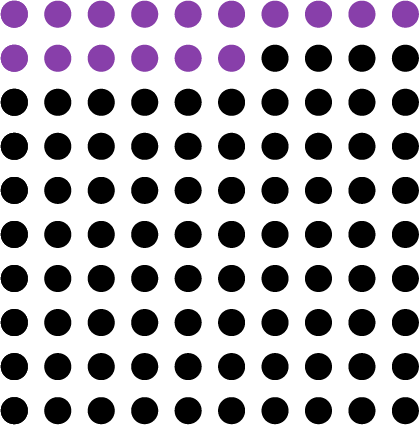B1.6 Describe relationships and show equivalences among fractions and decimal numbers up to thousandths, using appropriate tools and drawings, in various contexts.
Skill: Describing Relationships and Representing Equivalences Among Fractions, Decimal Numbers to Thousandths, and Percents, Using Appropriate Tools and Diagrams, in a Variety of Contexts
Students should understand that since decimal notation is just another way of representing a decimal fraction, then it is possible to establish an equality relationship between the two notations (for example, \(0.3\; = \frac{3}{{10}}\)). By recognizing this equality, they are able to associate a place value with each of the decimals that make up a decimal number, that is, tenths, hundredths, thousandths and so on.
Example

Students who do not understand this association are sometimes inclined to represent a fraction such as \(\frac{2}{5}\) as 0.2 or 0.25. The following examples describe observable behaviours of students who have developed a conceptual understanding of numbers and the relationship between their different representations.
Conceptual Understanding of Numbers
Number: 0.3
Observable behaviours:
- The student reads it as three tenths.
- The student can write the number in fractional notation as \(\frac{3}{{10}}\).
- The student can represent the number using concrete materials or visuals.
Example

Number: \(\frac{16}{100}\)
Observable behaviours:
- The student reads it as sixteen hundredths.
- The student can write the number in decimal notation as 0.16.
- The student can represent the number using concrete materials or visuals.
Example

Number: \(\frac{2}{7}\)
Observable behaviours:
- The student reads it as two sevenths.
- The student knows that the fraction \(\frac{2}{7}\) is not represented by 0.2 since they know that 0.2 = \(\frac{2}{10}\).
To establish the equality relationship between a fraction whose denominator is not a power of ten (for example,\(\frac{1}{4}\)) and the corresponding decimal number, it is necessary to use the concept of equivalent fractions. For example, students can use strips of equal length as shown below to see that \(\frac{1}{4}\) is between \(\frac{2}{10}\) and \(\frac{3}{10}\).

They then partition the tenths into ten equal parts, thus creating one hundred equal parts, or hundredths of the whole, and recognize that \(\frac{25}{100}\) is an equivalent fraction to \( \frac{1}{4}\).

Since \(\frac{{25}}{{100}}\; = \;0.25\), they can conclude that the fraction \(\frac{1}{4}\) can also be represented in decimal notation by 0.25 (\(\frac{1}{4}\; = \;\frac{{25}}{{100}}\; = \;0.25\)). This kind of example allows students to recognize that all fractions that can be expressed by an equivalent decimal fraction can be represented by a decimal number. This is particularly the case for fractions expressed in halves, fourths, fifths and twentieths, as shown in the following table.
| Fraction | Equivalent Decimal Fraction | Decimal Number |
|---|---|---|
| \(\frac{1}{2}\) | \(\frac{5}{{10}}\) | 0.5 |
| \(\frac{3}{4}\) | \(\frac{75}{100}\) | 0.75 |
| \(\frac{2}{5}\) | \(\frac{4}{10}\) | 0.4 |
| \(\frac{7}{20}\) | \(\frac{35}{100}\) | 0.35 |
Note: Some fractions (for example, \(\frac{2}{3}\), \(\frac{3}{7}\), \(\frac{5}{{11}}\)) cannot be represented by an equivalent decimal fraction. They can, however, be expressed by decimal numbers with a repeating decimal part (for example, \(\frac{2}{3}\; = \;0.\dot{6}\); \(\frac{3 }{7}\; = \;0.\dot{4}\dot{2}\dot{8}\dot{5}\dot{7}\dot{1}\); \(\frac{5}{{11}}\; = \;0.\dot{4}\dot{5}\)). The decimal representation is determined by dividing the numerator by the denominator.
Source: translated from Guide d’enseignement efficace des mathématiques de la 4e à la 6e année, Numération et sens du nombre, Fascicule 3, Nombres décimaux et pourcentages, p 46-48.
